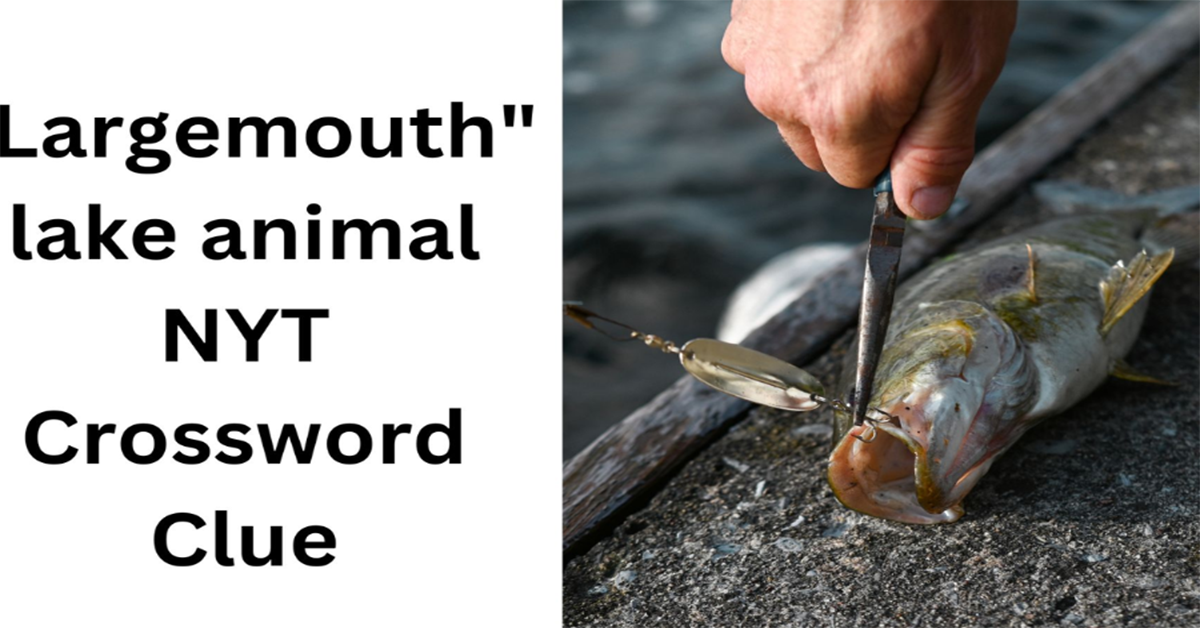Introduction to Largemouth Lake Animals
The underwater world of freshwater lakes is a fascinating environment, teeming with life and mystery. Among the most intriguing inhabitants is the largemouth lake animal, often used as a colloquial term to describe the largemouth bass (Micropterus salmoides). Known for its size, strength, and adaptability, this fish is a favorite among anglers and a critical player in the lake ecosystem. The largemouth bass exemplifies the balance of predator-prey relationships within freshwater habitats.
Largemouth bass are predatory fish that thrive in warm, slow-moving waters. They are commonly found in lakes, rivers, and ponds across North America. Recognizable by their broad mouth and olive-green coloration, largemouth bass are known for their voracious appetite and aggressive behavior, often preying on smaller fish, insects, and amphibians.
In this article, we will delve into the world of largemouth lake animals, focusing on their unique characteristics, habitat, diet, and importance within freshwater ecosystems. We will also explore their significance in recreational fishing and the environmental impact they have on their habitats.
The Largemouth Bass: A Freshwater Predator
Largemouth bass, sometimes referred to as “lake animals,” are apex predators in their freshwater environments. These fish are known for their territorial nature and ability to adapt to various conditions. They are generally most active during the warmer months, when their prey is abundant.
Largemouth bass are part of the Centrarchidae family, which includes other popular game fish such as bluegill and crappie. One of the key identifying features of the largemouth bass is the size of its mouth, which extends beyond the rear edge of its eye. This adaptation allows it to consume a wide variety of prey, making it a highly successful predator.
Habitat and Distribution of Largemouth Bass
Largemouth bass are native to North America, with their range extending from the Great Lakes down to Florida and across the Mississippi River basin. They have been introduced to other regions globally, including Japan, South Africa, and parts of Europe, where they are also popular among anglers.
These fish prefer shallow, slow-moving waters with plenty of vegetation, which provides both cover and abundant feeding opportunities. They are often found in lakes, ponds, rivers, and reservoirs, thriving in waters that are warm and nutrient-rich. The presence of submerged structures such as fallen trees, rocks, and aquatic plants creates an ideal habitat for largemouth bass, where they can ambush prey.
Diet and Hunting Behavior
Largemouth bass are opportunistic feeders with a diet that includes a wide variety of organisms. They primarily consume smaller fish, such as bluegill, shad, and minnows. However, their diet can also include frogs, crayfish, insects, and even small birds or mammals that venture too close to the water.
Their hunting behavior is characterized by sudden bursts of speed to capture prey. Largemouth bass are ambush predators, using stealth and the element of surprise to their advantage. They are particularly active during dawn and dusk, which are prime feeding times for many aquatic animals.
The Role of Largemouth Bass in the Ecosystem
Largemouth bass play a crucial role in maintaining the balance of freshwater ecosystems. As top predators, they help regulate the populations of smaller fish and other aquatic species. By controlling prey populations, largemouth bass contribute to the overall health of the ecosystem, preventing any single species from becoming too dominant.
This predator-prey relationship is essential for maintaining biodiversity in lakes and rivers. Without predators like the largemouth bass, prey species could overpopulate, leading to a decline in water quality and the collapse of the ecosystem.
Largemouth Bass and Recreational Fishing
Largemouth bass are one of the most popular game fish in North America, with millions of anglers targeting them each year. Bass fishing has become a major industry, with tournaments, equipment, and specialized techniques dedicated to catching this prized fish.
The challenge of catching largemouth bass, combined with their size and fighting ability, makes them a favorite among sport fishers. The “catch and release” philosophy is often practiced in bass fishing to ensure that populations remain healthy and sustainable.
In many regions, largemouth bass are managed through conservation efforts and fishing regulations to maintain their populations and protect the aquatic habitats they rely on.
Conservation and Environmental Impact
While largemouth bass are adaptable and resilient, they are not immune to environmental pressures. Habitat loss, pollution, and the introduction of invasive species can all negatively impact bass populations. Efforts to conserve their habitats are critical to ensuring their continued survival.
Pollution, particularly from agricultural runoff and industrial waste, can lead to water quality issues that affect the entire food chain, from the smallest invertebrates to top predators like the largemouth bass. Conservation efforts often focus on preserving wetlands, reducing pollution, and restoring natural water systems to support healthy fish populations.
Invasive Species and Competition
In some regions, largemouth bass have become invasive species, outcompeting native fish and disrupting local ecosystems. Their introduction to non-native environments, such as Japan and parts of Europe, has led to declines in indigenous fish species.
Managing the spread of largemouth bass in non-native habitats is important for preserving local biodiversity. In some areas, measures have been taken to control bass populations and protect native species from being driven to extinction.
Adaptations for Survival
Largemouth bass possess several adaptations that have enabled them to become successful predators. Their large mouths allow them to consume a variety of prey, while their streamlined bodies enable them to move quickly through the water. Additionally, their coloration provides camouflage in the aquatic vegetation, helping them ambush prey.
Their ability to tolerate a range of temperatures and water conditions has also contributed to their widespread distribution. Largemouth bass can survive in waters with low oxygen levels and have been known to thrive in environments that other fish species find challenging.
Lifespan and Reproduction
Largemouth bass have an average lifespan of 10 to 16 years in the wild, though some individuals have been known to live longer under ideal conditions. Their reproductive cycle begins in the spring, when water temperatures reach around 60°F (15.5°C).
During spawning, males create nests in shallow water by clearing away debris with their tails. Females lay eggs in these nests, and the males guard them until they hatch. A single female can produce thousands of eggs, though only a small percentage will survive to adulthood.
Fishing Techniques and Strategies
For anglers targeting largemouth bass, understanding their behavior and preferred habitats is key to success. Popular fishing techniques include using lures that mimic the movement of prey, such as crankbaits, jigs, and soft plastics.
Largemouth bass are often found near structures like fallen trees, docks, and submerged vegetation. Fishing in these areas during the early morning or late afternoon increases the chances of success, as bass are more active during these times.
The Cultural Significance of Largemouth Bass
Beyond their ecological importance, largemouth bass hold a special place in North American culture, particularly in the southern United States. Bass fishing is not just a recreational activity but a tradition passed down through generations. The fish has become a symbol of the outdoor lifestyle and a connection to nature.
In popular culture, largemouth bass are often associated with images of pristine lakes, peaceful mornings on the water, and the thrill of a catch. This cultural significance has helped fuel the growth of the bass fishing industry and its associated events.
Famous Largemouth Bass Catches
Throughout history, there have been numerous stories of record-breaking largemouth bass catches that have captured the imagination of anglers worldwide. The current world record, set in 1932 by George Perry in Georgia, stands at 22 pounds, 4 ounces (10.12 kg). This record has become the holy grail for bass anglers, inspiring countless attempts to surpass it.
In recent years, advances in fishing technology and the spread of largemouth bass to new environments have led to more large bass being caught, though Perry’s record remains unbroken.
How Climate Change Affects Largemouth Bass
Climate change poses new challenges for largemouth bass and other freshwater species. Rising temperatures can alter the timing of spawning, reduce available habitat, and lead to more extreme weather events that affect water quality. Warmer waters may also favor the spread of invasive species that compete with bass for resources.
Conservation efforts must consider the impact of climate change on freshwater ecosystems to ensure that largemouth bass populations remain resilient in the face of these challenges.
The Future of Largemouth Bass Fishing
The future of largemouth bass fishing will depend on sustainable practices and continued conservation efforts. As more people become interested in fishing, the pressure on bass populations will increase. Education on responsible fishing practices and the importance of protecting aquatic habitats will be key to preserving this beloved species for future generations.
Technological advancements, such as fish finders and improved tackle, will continue to shape the way anglers approach bass fishing. However, the core experience of connecting with nature and the thrill of the catch will remain central to the sport.
The Global Influence of Largemouth Bass
While largemouth bass are native to North America, their introduction to other parts of the world has made them a global species. In places like Japan, bass fishing has become a popular sport, with tournaments and dedicated anglers contributing to the growth of the industry.
The spread of largemouth bass to non-native environments highlights the complex relationship between humans and the natural world. While bass fishing provides recreational opportunities and economic benefits, it also raises questions about the impact of introducing species to new ecosystems.
Conclusion
The largemouth bass, often referred to as the “largemouth lake animal,” is a vital part of freshwater ecosystems and a beloved target for anglers around the world. Understanding the behavior, habitat, and importance of this species helps to ensure its conservation and continued role in maintaining healthy aquatic environments. As the impact of climate change and human activity on freshwater ecosystems continues to grow, preserving the largemouth bass and its habitat will be essential for the future of recreational fishing and biodiversity.
FAQs
Q1: What is the best time of year to fish for largemouth bass?
A1: The best time to fish for largemouth bass is typically during the spring and fall, when water temperatures are moderate, and the bass are more active. Early morning and late afternoon are also prime times for bass fishing.
Q2: How big can largemouth bass grow?
A2: Largemouth bass can grow up to 25 inches in length and weigh over 20 pounds, though the average size is usually between 12 and 15 inches and 1 to 5 pounds.
Q3: Are largemouth bass aggressive?
A3: Yes, largemouth bass are known for their aggressive behavior, especially when defending their territory or hunting prey. This aggression makes them a popular target for sport fishers.
Q4: How do largemouth bass reproduce?
A4: Largemouth bass reproduce in the spring. Males build nests in shallow water, where females lay eggs. The males guard the eggs until they hatch, ensuring the survival of the offspring.
Q5: Can largemouth bass live in both fresh and brackish water?
A5: Largemouth bass primarily inhabit freshwater environments, but they can tolerate brackish water with low salinity levels.
Q6: What is the world record for the largest largemouth bass?
A6: The world record for the largest largemouth bass is 22 pounds, 4 ounces, caught by George Perry in Georgia in 1932.




